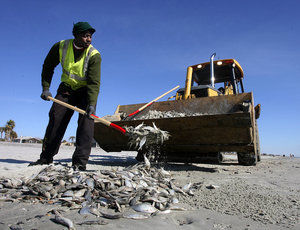
Trey Smalls, with B & C Utilities, cleans up the fish kill on Folly Beach
Folly Beach-- The fish kill was Gene Nelson's opportunity to scoop up free fertilizer. Nelson arrived early Friday to collect buckets of dead menhaden, filling three or four loads of the finger-length fish. He plans to bury them as tree feed ahead of planting season.
"You've got to put them in the ground right away," said Nelson, of North Charleston, who wore rubber gloves as he bent over on his hands and knees pulling loads in.
Nelson wasn't the only scooper on site. Down the beach, work crews hired by the city of Folly Beach used shovels and heavy duty earth-moving equipment to clean a mile-and-a-half stretch of thousands of stinking menhaden carcasses that had washed ashore earlier this week. Officials expect the work to be all done by today, at a cost of between $5,000 and $6,000.
While state wildlife officials said the die-off appears to be a product of the recent cold and lower sea temperatures, some locals said there is reason to be concerned about stress on the ocean's environment.
"These are bait fish that larger fish feed on," local resident Tom Jerussi said. "So it might impact the fishing this year."
He also wondered if it truly was the just the weather that's responsible.
"It's been this cold before."
Temperatures offshore and in Charleston Harbor this week were in the upper 40s.
Other locals said they saw the disaster coming a few days ago. Kathy Ashworth, who walks the beach daily, said she saw giant schools of menhaden just off shore Wednesday, moving in groups so thick that numerous hungry dolphin were attracted to the buffet.
"I've never seen that many in one place before," she said.
Menhaden are smaller bait fish that travel in large schools, and tend to move farther south as waters cool. They swim shallower than other fish, and can be more susceptible to cold patches of water. The number found dead isn't so startling, some say, because the schools tend to be massive.
Friday morning's high tide wasn't high enough to take many of the dead back out to sea. One of the thicker accumulations was above the surf line just north of the Folly Beach pier, where a week ago many hundreds of people gathered for the annual New Year's polar bear swim. Meanwhile, birds of all kinds gorged themselves up and down the beach.
State wildlife biologists who responded to the kill reported earlier the menhaden had been otherwise healthy, and officials at other nearby beaches had no reports of fish kills there.
Folly Beach Director of Public Works Stephen Robinson said the plan is for a contract crew to remove the fish using heavy equipment and transporting the recovery to the Bee's Ferry landfill for disposal.
Mark Williams, an incident responder with the state Department of Health and Environmental Control, said there is nothing environmentally irregular to moving dead fish to a landfill, though Folly's course is different than most in that it is eager to clear the beach sooner than a more isolated place would, he said.
"Most fish kills are not done that way," Williams said, adding most are left up to "Mother Nature" to resolve. But in this case, Folly wanted the beach cleared so people can keep using the beach. Otherwise, "you'd have the odor and some mess to deal with," Williams said.
Jerussi said he had no problem with the speed of Friday's cleanup. "They will stink like crazy in another day," he said.
Reader Comments
to our Newsletter